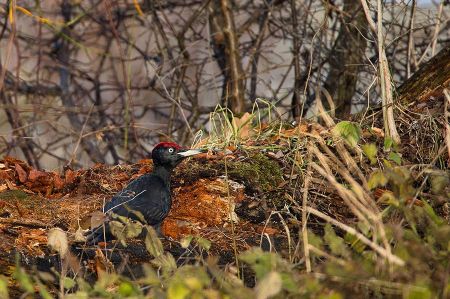Courtship season of black woodpecker begins in mid-February
- Written by Portal Editor
While the marching bands march through the carnival strongholds on Rose Monday to the sound of drums, a completely different performance takes place in the forests; Here attentive walkers can hear the drum roll of the black woodpecker.
The courtship season of the bird from the subfamily of real woodpeckers begins in mid-February.
If sweet tree sap flows through a hole ...
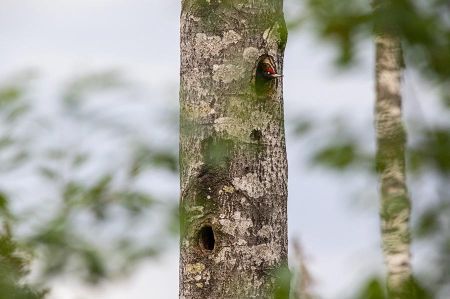 The black woodpecker is slightly smaller than a carrion crow, but just as pitch black, and its head is adorned with a shock of bright red hair. Woodpeckers are loud and clever: “The male woodpecker uses his drumming to attract the female. The more intense the drumming, the better. And the hollower the tree trunk, the more resonance the drum roll receives. That's why woodpeckers primarily look for hollow trunks for courtship drumming, which amplify the sound," explains Jenifer Calvi from the German Wildlife Foundation. Native gray, three-toed and great spotted woodpeckers also master this clever form of courtship. “And particularly clever woodpeckers like to look for satellite dishes, rain pipes or gutters near settlements instead of trees, researchers have observed. Because they sound extra loud because of the metal,” says Calvi.
The black woodpecker is slightly smaller than a carrion crow, but just as pitch black, and its head is adorned with a shock of bright red hair. Woodpeckers are loud and clever: “The male woodpecker uses his drumming to attract the female. The more intense the drumming, the better. And the hollower the tree trunk, the more resonance the drum roll receives. That's why woodpeckers primarily look for hollow trunks for courtship drumming, which amplify the sound," explains Jenifer Calvi from the German Wildlife Foundation. Native gray, three-toed and great spotted woodpeckers also master this clever form of courtship. “And particularly clever woodpeckers like to look for satellite dishes, rain pipes or gutters near settlements instead of trees, researchers have observed. Because they sound extra loud because of the metal,” says Calvi.
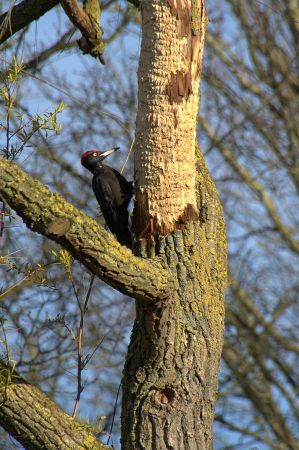 A black woodpecker can hit the bark with its beak up to 17 times per second, reaching an average impact speed of 25 kilometers per hour. The woodpecker's head acts like a hammer when it hits the ground. “A special interaction of muscles and bones in its head ensures that the woodpecker neither gets a headache nor does the brain suffer damage when hammering,” says Calvi. The birds also find their food by knocking off the tree bark: beetles, spiders and larvae are on the woodpecker menu. People also drink on trees: they use their beaks to punch holes in hornbeams, birches or maple trees. If sweet tree sap flows through a hole, the feathered creatures catch the liquid in their movable lower beak before swallowing it - swallowing woodpeckers.
A black woodpecker can hit the bark with its beak up to 17 times per second, reaching an average impact speed of 25 kilometers per hour. The woodpecker's head acts like a hammer when it hits the ground. “A special interaction of muscles and bones in its head ensures that the woodpecker neither gets a headache nor does the brain suffer damage when hammering,” says Calvi. The birds also find their food by knocking off the tree bark: beetles, spiders and larvae are on the woodpecker menu. People also drink on trees: they use their beaks to punch holes in hornbeams, birches or maple trees. If sweet tree sap flows through a hole, the feathered creatures catch the liquid in their movable lower beak before swallowing it - swallowing woodpeckers.
Even though there are suitable cave trees...
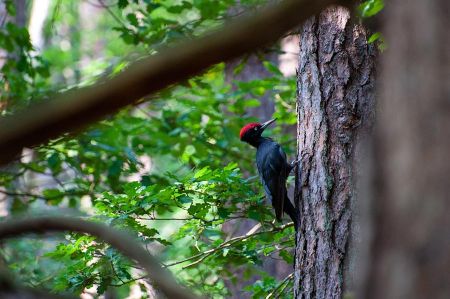 But the ivory-colored beak is not only used for courtship and feeding: black woodpeckers use it as a tool to build the largest tree hollows in a forest. The carpenter cleverly exploits natural conditions: “If the entrance hole is under a ridge of bark like under a canopy, no rainwater runs into the cave. Truly clean trunks ensure a clear view when flying in and out,” says Calvi. Inside the trunk, the living cave is sometimes built up to a meter deep. The black woodpecker is particularly fond of old, hundred-year-old beech trees with thick trunks. Here he can build a cave that offers enough space for the offspring: four to six chicks hatch from the porcelain white eggs. Later, when the young have fledged and the parent birds also move to a new den, other wild animals use the domicile: stock dove, rough-legged owl, pine marten, dormice or goldeneye. The black woodpecker plays an important role in biodiversity in the forest.
But the ivory-colored beak is not only used for courtship and feeding: black woodpeckers use it as a tool to build the largest tree hollows in a forest. The carpenter cleverly exploits natural conditions: “If the entrance hole is under a ridge of bark like under a canopy, no rainwater runs into the cave. Truly clean trunks ensure a clear view when flying in and out,” says Calvi. Inside the trunk, the living cave is sometimes built up to a meter deep. The black woodpecker is particularly fond of old, hundred-year-old beech trees with thick trunks. Here he can build a cave that offers enough space for the offspring: four to six chicks hatch from the porcelain white eggs. Later, when the young have fledged and the parent birds also move to a new den, other wild animals use the domicile: stock dove, rough-legged owl, pine marten, dormice or goldeneye. The black woodpecker plays an important role in biodiversity in the forest.
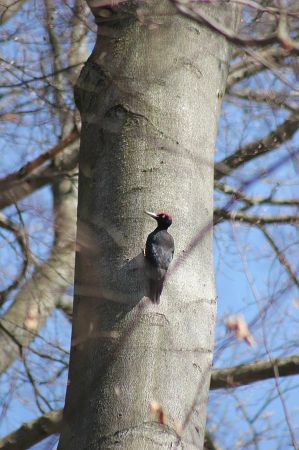 “With an estimated 30,000 black woodpecker breeding pairs in Germany, the population is stable. And because there are more and more old trees in the forests in Germany, the population can still increase,” says Calvi. Nevertheless, he suffers from the changes in the forests. If there is too much natural regeneration in the forest where a black woodpecker lives, its habitat quickly becomes unsuitable. Black woodpeckers only escape their main enemy, the hawk, by evading him in a rapid zigzag flight close to the ground. If a black woodpecker is hindered by young, growing trees, it has little chance of shaking off the bird of prey. Then he leaves the forests, even though there are suitable cave trees there for him.
“With an estimated 30,000 black woodpecker breeding pairs in Germany, the population is stable. And because there are more and more old trees in the forests in Germany, the population can still increase,” says Calvi. Nevertheless, he suffers from the changes in the forests. If there is too much natural regeneration in the forest where a black woodpecker lives, its habitat quickly becomes unsuitable. Black woodpeckers only escape their main enemy, the hawk, by evading him in a rapid zigzag flight close to the ground. If a black woodpecker is hindered by young, growing trees, it has little chance of shaking off the bird of prey. Then he leaves the forests, even though there are suitable cave trees there for him.
The German Wildlife Foundation protects the fascinating black woodpecker. At Gut Klepelshagen in Mecklenburg-Western Pomerania, she leaves so-called habitat trees for black woodpeckers in old, shady beech forests for the life of the tree. Four breeding pairs are currently courting here - the offspring can come!
Jenifer Calvi
Press officer
German Wildlife Foundation
Please read as well:
Girne / Kyrenia - middleage Castle and Harbour
Amazonia by Yadegar Asisi – Fascination of tropical rainforest
